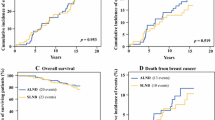Abstract
Background
Sentinel lymph node biopsy (SLNB) has become a standard for axillary staging for early breast cancer patients. Prior studies suggest that SLNB may be more sensitive for the identification of lymph node disease than axillary lymph node dissection (ALND). We hypothesized that SLNB use increases the incidence of node-positivity in early breast cancer patients compared to ALND. Furthermore, survival improves due to more accurate staging (stage migration).
Methods
Registry data from an NCI-designated cancer center was reviewed for breast cancer patients with T1 and T2 tumors for two 5-year periods: before (1993–1997) and after (2000–2004) SLNB implementation (1998). TNM staging was updated to conform to American Joint Committee on Cancer (AJCC) 2003 guidelines.
Results
There were no differences in tumor size or stage groupings between the two time periods (n = 316 and 577). There was a non-significant increase in the proportion of patients with lymph node involvement (32 vs. 27%; P = .16) after SLNB implementation; though a trend of increased incidence of single-node positive patients was observed (13 vs. 8%; P = .07). This was significant in patients with T1A/T1B tumors (10 vs. 3%; P = .04), though not seen in T1C or T2 tumors. Stage II survival improved in the later time period (P = .02).
Conclusions
The increase in single-node positivity after SLNB implementation supports the theory that SLNB is more sensitive than ALND. Improvements in survival are likely due to the stage migration of patients who would have been node-negative by ALND (but were found to be node-positive by SLNB) in addition to improvements in adjuvant therapy.



Similar content being viewed by others
References
Feinstein AR, Sosin DM, Wells CK. The Will Rogers phenomenon. Stage migration and new diagnostic techniques as a source of misleading statistics for survival in cancer. NEJM 1985; 312:1604–8
Ghafoor A, Jemal A, Ward E, Cokkinides V, Smith R, Thun M. Trends in breast cancer by race and ethnicity. CA Cancer J Clin 2003; 53:342–55
Singletary SE, Allred C, Ashley P, et al. Revision of the American Joint Committee on Cancer staging system for breast cancer. J Clin Oncol 2002; 17:3628–36
Woodard WA, Strom EA, Tucker SL, et al. Changes in the 2003 American Joint Committee on Cancer staging for breast cancer dramatically affect stage-specific survival. J Clin Oncol 2003; 21:3244
NIH consensus conference. Treatment of early-stage breast cancer. JAMA 1991; 65:391–5
Krag DN, Weaver DL, Alex JC, Fairbank JT. Surgical resection and radiolocalization of the sentinel lymph node in breast cancer using a gamma probe. Surg Oncol 1993; 2:335–9
Giuliano AE, Kirgan DM, Guenther JM, Morton DL. Lymphatic mapping and sentinel lymphadenectomy for breast cancer. Ann Surg 1994; 220:391–8
Ross MI. Sentinel node dissection in early-stage breast cancer: ongoing prospective randomized trials in the USA. Ann Surg Oncol 2001; 77S–81S
Krag DN, Julian TB, Harlow SP, et al. NSABP-32: Phase III, randomized trial comparing axillary resection with sentinel lymph node dissection: a description of the trial. Ann Surg Oncol 2004; 11:208S–10S
Edge SB, Niland JC, Bookman MA, Theriault RL, Ottesen R, Lepisto E, Weeks JC. Emergence of sentinel node biopsy in breast cancer as standard-of-care in academic comprehensive cancer centers. J Natl Cancer Inst 2003; 95:514–21
Consensus statement on guidelines for performance of sentinel lymphadenectomy for breast cancer. American Society of Breast Surgeons (October 2003). Available at: http://www.breastsurgeons.org/officialstmts/sentinel.shtml. (accessed December 29, 2005)
Schwartz GF, Giuliano AE, Veronesi U. Proceedings of the consensus conference on the role of sentinel lymph node biopsy in carcinoma of the breast, April 19–22, 2001, Philadelphia, Pennsylvania. Cancer 2003; 94:2542–51
Singh-Ranger G, Mokbel K. The sentinel node biopsy is a new standard of care for patients with early breast cancer. Int J Fertil Womens Med 2004; 49:225–7
Schrenk P, Rieger R, Shamiyeh A, Wayand W. Morbidity following sentinel lymph node biopsy versus axillary lymph node dissection for patients with breast carcinoma. Cancer 2002; 88:608–14
Peintinger F, Reitsamer R, Stranzl H, Ralph G. Comparison of quality of life and arm complaints after axillary lymph node dissection vs. sentinel lymph node biopsy in breast cancer patients. Br J Cancer 2003; 89:648–52
Schijven MP, Vingerhoets AJ, Rutten HJ, Nieuwenhuijzen GA, Roumen RM, van Bussel ME, Voogd AC. Comparison of morbidity between axillary lymph node dissection and sentinel node biopsy. Eur J Surg Oncol 2003; 29:341–50
Cody HS, Borgen PI, Tan LK. Redefining prognosis in node-negative breast cancer: can sentinel lymph node biopsy raise the threshold for systemic adjuvant therapy? Ann Surg Oncol 2004; 11:227S–30S
Dowlatshahi K, Fan M, Snider HC, Habib FA. Lymph node micrometastases from breast carcinoma: reviewing the dilemma. Cancer 1997; 80:1188–97
Cote RJ, Peterson HF, Chaiwun B, et al. Role of immunohistochemical detection of lymph-node metastases in management of breast cancer. International Breast Cancer Study Group. Lancet 1999; 354:896–900
Chu KU, Turner RR, Hansen NM, Brennan MB, Bilchik A, Giuliano AE. Do all patients with sentinel node metastasis from breast carcinoma need complete axillary node dissection? Ann Surg 1999; 229:536–41
McCready DR, Yong WS, Ng AK, et al. Influence of the new AJCC breast cancer staging system on sentinel lymph node positivity and false-negative rates. J Natl Cancer Inst 2004; 96:873–5
Montero A, Fossella F, Hortobagyi G, Valero V. Docetaxel for the treatment of solid tumours: a systematic review of clinical data. Lancet Oncol 2005; 6:229–39
Acknowledgments
We would like to thank Juanita Pratt of the UC Davis Cancer Registry for providing the data for this study.
Author information
Authors and Affiliations
Corresponding author
Rights and permissions
About this article
Cite this article
Vanderveen, K.A., Schneider, P.D., Khatri, V.P. et al. Upstaging and Improved Survival of Early Breast Cancer Patients after Implementation of Sentinel Node Biopsy for Axillary Staging. Ann Surg Oncol 13, 1450–1456 (2006). https://doi.org/10.1245/s10434-006-9109-6
Received:
Revised:
Accepted:
Published:
Issue Date:
DOI: https://doi.org/10.1245/s10434-006-9109-6




